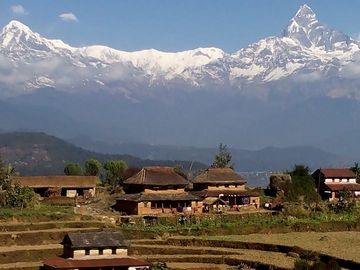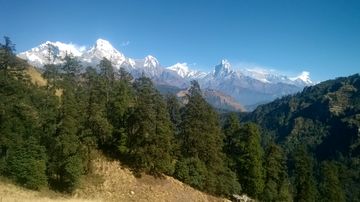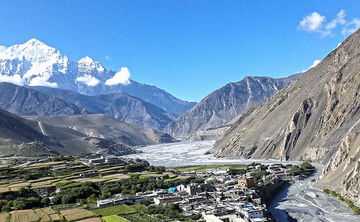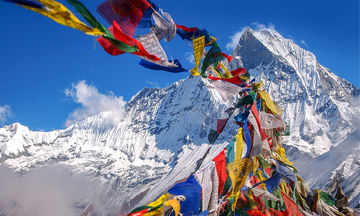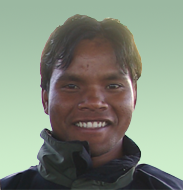
Introduction
My name is Shiva Bishwokarma. I am a trekking guide in the Annapurna region of Nepal. I hope that my website will help make you interested in visiting my beautiful country, and to come trekking with me in our corner of the Himalayas.
The treks
Nepal has become the worlds favourite trekking destination for many good reasons - with stunning Himalayan landscapes and hospitable people it is hard not to want to come back again and again after your first visit.
All of the treks listed here are "tea-house" treks, meaning that there is accommodation and food available along the route so there is no need to carry tents and provisions. The main base for accessing the Annapurna region is Pokhara, a pleasant town with good facilities located by the Phewa Tal lake.
The high-seasons for trekking in Nepal is between September and November (Autumn) and between March and May (Spring) , but visiting out of season or during shoulder-seasons can be a great idea if you prefer a more quiet experience. All the photos on this page were taken during June when the trails are nearly empty, a great time for wild-flowers but with a slightly higher risk of rain. Winter is great for trekking low (below 3000 meters). April is ideal to see rhododendron flowering on the hillsides.
Annapurna Base Camp
The trek to the Annapurna Basecamp is one of the most stunning in Nepal, taking in a varied mix of landscapes. The first days of the trek pass through picturesque Himalayan villages, with terraced rice fields and stunning views - the villages in this area can only be reached by foot which helps them retain their charm. As part of the trek we climb the 3200 meter Poon Hill for gorgeous sunrise views towards a range of 7000 and 8000 meter peaks (see more details and photos from the Poon Hill trek in the section below).
Later parts of the trek pass through more remote and less inhabited areas, with deep mossy fern-filled forests. There are no villages here, but mountain lodges have been set up to make sure trekker accommodation is available along the whole trail.
The final day of the climb up towards the basecamp passes through a deep valley with waterfalls crashing down the mountain sides, as the forest gives way to alpine meadows and wildflowers. The trail crosses one or two small glaciers before finally reaching the Annapurna Sanctuary. The Sanctuary itself is closed in on all sides by 7000-8000 meter mountains, with the valley that you have trekked through providing the only possible access. It is hard to imagine a more secluded location.
The trek takes roughly ten days, reaching basecamp at 4100 meters altitude on day six, before returning via a separate route and different villages. One night on the way back can be spent in the village of Jhinu, which lies close to a natural hotspring by a river in the forest - perfect for soaking those trekking legs!
Sample route: Pokhara -> Nayapul -> Tikhedhunga -> Ghorepani -> Poon Hill -> Ghorepani -> Tadapani -> Chhomrong -> Dovan -> Annapurna Basecamp -> Bamboo -> Jhinu -> Pothana -> Phedi -> Pokhara
Poon Hill
Poon Hill is a great trek if you are short on time - giving you a good sample of some of the best of the Annapurna region in just 3-5 days of trekking.
The highlight is watching the sunrise from 3200 meter Poon Hill, after climbing the final stretch from the nearby village of Ghorepani in the early morning. You will see the sun rise over the famous "fish-tail" or Machhapuchhre mountain - 6993 meters high, with great views towards several of the worlds highest mountains such as the 8167 meter Dhaulagiri.
The walk to reach Ghorepani follows the same route as the first two days of the Annapurna Basecamp trek - passing through charming remote villages, terraced ricefields on the hillsides and stunning forest covered in orchids and epiphytes.
Sample route: Pokhara -> Nayapul -> Tikhedhunga -> Ghorepani -> Poon Hill -> Ghorepani -> Tadapani -> Ghandruk -> Pokhara
Annapurna Circuit
The longest standard trek in the area, the Annapurna Circuit circles the whole Annapurna range and takes between 16 and 21 days to complete. The northern part of the trek lies in the rainshadow from the Annapurna mountains, with very different types of landscapes and Tibetan Buddhist areas.
The Annapurna Circuit can be combined with the Annapurna Basecamp for an even more complete experience.
Sample route: Pokhara -> Bhulbule -> Ghermu -> Tal -> Danagyu -> Chame -> Pisang -> Manang -> Yak Kharka -> Thorung Phedi -> Muktinath -> Kagbeni -> Jomsom -> TuKuche -> Kalopani -> Dana -> Tatopani -> Pokhara
Royal Trek
This trek is a chance to get off the beaten track. There are no tea-houses along this trek and accommodation is homestays in villages along the way. The trek allows you to get close to Nepali culture, stay in traditional villages and eat local food. The mountain scenery is beautiful and you can watch the sunrise from 2500 meters. The trek can be two, three, or four nights long. The Royal trek starts from the beautiful Lakeside city of Pokhara. The trekking trail passes through rice terraces and green bamboo and pine forests into less crowded areas before reaching Harpan Khola. The Royal trek is suitable for beginners to explore the mountain views and traditional Nepalese villages. This trek is also great for those who have very limited time to trek but want to experience the mountain views, local culture and traditional lifestyle of Himalayas. Royal trek is one of the shortest trekking tours around Annauprna, and provides opportunities to experience the mixed culture of mid hills with superb views over mountains like Fishtail, Annauprna, Dhaulagiri and many others.
Sample route: Pokhara -> Day 01 Drive to Sedi ( 20 m ) - trek to Kaskikot 4 hrs -> Day 02 Kaskikot - Bhadaure -> Day 03 Bhadaure - Bhanjyang -> Day 04 Bhanjyang - Harpan Khola to Drive Pokhara
Mardi Himal Trek
The Mardi Himal trek is a hidden gem in the Annauprna region. Few trekkers make their way to the Mardi Himal Base Camp spectacularly situated at the base of Mardi Himal and the impressive Machapuchhre. The trail goes along small winding paths, though magical Rhododendrons forest until you climb out of the forest at an elevation of 3300m. The landscape changes quite abruptly into a rugged high mountain landscape, with amazing views of Mardi Himal Machapuchhre, Annauprna South and Hiumchuli. From High Camp (3580m) you can climb up to Mardi Himal Base Camp in about 3-4 hours which offers spectacular views of the entire Annauprna Ranges.
Sample route: Pokhara -> Day 01 Drive to Kande (1 hrs ) trek to Pitam Deurali 2100m -> Day 02 Pitam Deurali ( 2100 m ) - Forest Camp ( 2550 m ) 4- 5 hrs -> Day 03 Forest Camp ( 2550 m ) - Low Camp ( 2990 m ) 3 hrs -> Day 04 Low Camp ( 2990 m ) - High Camp ( 3580 m ) 3 hrs -> Day 05 Day Hike to Mardi Himal Base Camp ( 4500 m ) and return to High Camp ( 3580 m ) 6 - 7 hrs -> Day 06 High Camp ( 3580 m ) - Sidhing ( 1850 m ) 6 hrs -> Day 07 Sidhing ( 1850 m ) - Lumle 3 hrs Drive to Pokhara
Jomsom and Muktinath Trek
Jomsom and Muktinath trek is an Annauprna region trek that passes through deep valley and high mountain encircling the gaint Annauprna mountain along with diverse landscapes and cultures which offers the perfect view into the rural life of Nepalies People. Muktinath is a famous pilgrimage site regarded as a secret place of salvation for the Hindu religion. Muktinath lies 18km north east of Jomsom in the Mustang district of Nepal at an elevation of 3749m. We start our trek from Pokhara and ascend the Annauprna foot hill through picturesque Gurung villages. The trail passes through rhododendron forest to climb poon Hill for astounding scenery of Dhawalagiri and Annauprna ranges. Walking in the gorge carved by the Kali Gandaki river is one of the key features of this trek. After trekking up to Kali Gandaki valley we pass through blooming village like Tukuche- Ghasa - Marfa and Jomsom. We countinue our trek through the arid Tibet like landscapes of Mustang passing Jomsom. Finally we reach Muktinath passing below Thorong La pass. We explore temples and villages and enjoy wonderful mountain scenery before taking the flight or Jeep back to Pokhara.
Sample route: -> Day 01 : Pokhara to Drive Nayapul and trek Tikhedunga ( 1570m ) -> Day 02 : Tikhedunga to Ghorepani ( 2840m ) -> Day 03 : Hike up to Poon Hill ( 3210m ) and trek to Tatopani ( 1190m ) -> Day 04 : Tatopani to Ghasa ( 2010m ) -> Day 05 : Ghasa to Tukuche ( 2586m ) -> Day 06 : Tukuche to Kagbeni ( 2810m ) -> Day 07 : Kagbeni to Muktinath ( 3202m ) -> Day 08 : Muktinath to Jomsom ( 2713m ) -> Day 09 : Jomsom to Pokhara flight or Jeep or car
Everest Base Camp Trek
Everest Base Camp Trek is one of the most famous treks in the world and passes through traditional Sherpa village full of monasteries and takes you to the top of the Base Camp of Mount Everest and Kalapathar for wonderful views over mountain ranges. Everest Base Camp trek offers an opportunity to enjoy the amazing view of Mt. Everest and several other peaks and to know the culture and tradition of local Sherpa. The trek passes through cultivated fields and small villages and explores Buddhists monasteries and shrine along with extraordinarily wildlife.
The Everest Base Camp expedition begins with an amazing flight right above numerous mountains to Tenzing Hillary airport at Lukla. The trek passes through the Dudh Kosi valley towards the village of Namche, a lively bazzar of the Everest Region. The journey towards the base camp passes through magnificent forests of rhododendron, magnolia and giant firs. From Namche bazar, ascending towards the Thyangboche monastery offers the first fine view of Mount Everest. From this point onwards, the scenery is so stunning. We then descend towards the Khumbu Glacier passing through Imja Khola and villages of Pangboche and Pheriche with spectacular views of the Ama Dablam, Taweche and other peaks with hike to Gorak Shep. Finally some amazing views of the Himalayan giants from Kalapattar.
Everest Base Camp Trek lets you explore the route the base of the world highest mountain. While trekking towards the Base Camp we encounter Sagarmatha National Park full of rare species of wildlife and birds like Musk deer, mountain Goat and many more. Pine, juniper, Rhododendron and magnolia flowers are the common plants found in the Everest region. Along with these wildlife and vegetation we also encounter the warm hospitality of the friendly Sherpa villages. A slow way up through wonderful Sherpa villages allows us time to take pleasure in the landscape and visit a number of monasteries. The primary highlights of the trek are stunning views of Mount Everest, exploring Sherpa culture, witnessing Namche Bazar, Tengboche Monastery, climbing Kalapattar, visit Everest Base Camp and many more.
Sample route: -> Day 01:Arrive to Kathamandu to Lukla flight -> Day 02: trek to Namche Bazar ( 3438m/ 11280ft 3- 4 hrs -> Day 03: Acclimatization day Namche Bazar -> Day 04 : Trek to Tengboche ( 3870m / 12694ft ) 4- 5 hrs -> Day 05 : Trek to Dingngpoche ( 4360m / 14300ft ) 5 hrs -> Day 06 : Trek to Lopuche ( 4940m / 161207ft ) 5 hrs -> Day 07 : Trek to Everest Base Camp ( 5300m / 17400ft ) -> Back to Gorek she ( 5170m / 16661ft ) -> Day 08 : Hike up to Kalapattar ( 5545m / 18192ft ) -> Then trek to periche ( 4270m / 14070ft ) -> Day 09 : Trek to Tengboche ( 3870m / 12694ft ) -> Day 10 : Trek to Namche Bazar ( 3438m / 11280ft ) -> Day 11 : Namche Bazar to Lukla ( 2840m / 9320ft ) -> Day 12 : Lukla to kathamandu by flight

About Me
My name is Shiva Bishwokarma and I have many years experience as a professional guide for tourists in this region. I know the area and the remote mountain villages well (I was lucky enough to grow up in one of them).
Recommendations
We were so lucky to have Shiva as a guide. He is so knowledgeable and
patient as well as being an outstanding guide he is so kind and
introduced us to his fantastic family, who greatly enhanced our
experience.
Thank you for making trek in A.B.C so memorable, you will always
have two friends in Ireland.
Good luck in the future,
A chairde
Barrai and Sarah
Shiva was our guide during our trek to the annapurna sanctuary. From
the first time we met shiva we could tell, he was friendly and
personable. He always looked out for our welfare and went over and
above the call of duty to make our trek enjoyable and care free. He
has been fantastic at explaining things we saw a long the way,
pointing out things of interest, and teaching us nepali phrases. He is
very capable on the trails and made us feel safe during potentially
dangerous points. We are happy to call shiva our friend and would
wholeheartedly recommend him as a guide for anyone going on an
annapurna trek.
Rebecca and Warren
We were very lucky to find Shiva and his family, without him our experience
here would have been superficial. Shiva is a very patient, dedicated,
honest and definitely a recommendable guide. Through him we had
contact with the local people from the mountain and he taught us about
his culture and habits so that we could learn a
lot.
We are very lucky with him during the trek. We saw beautiful
mountain views and sunrise from Poon hill in the early morning. Thank you,
Shiva for being a very special guide and for trekking us to see
exactly what we wanted and the best views.
Good luck and best wishes for you, see you next time.
Henry and Maria
We trekked to Annapurna Sanctuary with Shiva and his friend Deepak as guide and porter in June 2009, and it was one of the absolute highlights from
our year-long round-the-world trip.
Shiva was fantastic as a guide, always helping us find the best spots, and when our legs were slowing us down on the downhill stretches he and Deepak
used the extra time to pick us wild strawberries :-)
Edel and David
More recommendations are available on request.
Questions
Could I trek without a guide?
You could, the area is very safe and in most cases navigation is relatively easy - however with a guide you will get more out of the experience. Having someone with you that knows the local customs and language helps you interact with people you meet in remote villages, and shows that you respect their culture.
Why is it better hiring a guide directly, instead of going on an organized tour?
Booking an organized trek from abroad will cost you more money, with more agencies and middle-hands to go through. By hiring a guide directly you have full control over group-size, how fast you want to trek, and which route you want to take. You can also make sure that your guide is someone who actually comes from the area you will be trekking in. Finally, hiring a guide directly instead of booking with a foreign-owned agency helps you make sure that more of your money goes towards helping the area that you will be spending time in.
Do I need to hire a porter?
Most (if not all) of the treks in Nepal involve a fair amount of climbing. You will probably enjoy the trek more if you carry only a small bag with your camera and water. If you choose to trek with me I can help you find a reliable porter also.
How much does a guide or porter cost?
Guides in the Annapurna region currently (2013) charge roughly 20 US dollars per day, porters typically around 15 dollars per day. Package tour (including transport to and from the trek, accommodation during the trek, guide and porter, trekking permit, three meals per day, excluding drinks) is typically 60 dollars per person per day.
How much should I tip a guide or porter?
Provided the work was well performed, one extra days pay for every week worked is the custom (and the amount recommended in the Rough Guide to Nepal guidebook).
How do I find a guide or a porter?
You can ask around at your accommodation or other places in Pokhara - most of them would be able to contact a guide for you. Otherwise you can also ask directly near the trail-heads where you start the trek. Or you can email me on the address listed below (sbishwokarma@gmail.com).
How expensive is it to travel in Nepal?
For travellers from most parts of the world Nepal is also a very economic destination (accommodation along the trek might cost only 2-3 dollars per night for example).
What do I need to bring?
Good hiking boots, layered clothing, water purification tablets, sunscreen, rain coat, first-aid kit, lots of film or memory card space for your camera. Most items can easily be bought in Pokhara before starting the trek.
What is the food like on the trek?
Fantastic! If you haven't already tried Dal Bhat you are in for a treat - there is nothing better to fill that trekking appetite. Dal Bhat is the signature Nepali dish - rice and lentil soup served with two types of curried vegetables and pickles. It is on the menu in every tea-house on the trek. A nice breakfast speciality you might also want to try is Tibetan Gurung bread with honey. The mountain tea houses will also serve up more familiar western dishes like pizza, or muesli for the mornings.
Where can I find more information?
One great resource on the web is http://www.visitnepal.com/trekking/.Contact
My email address is sbishwokarma@gmail.com.
I can also be contacted via +977 98261 - 11460
or you can send me a message using the form below and I will get back to you as soon as possible.
